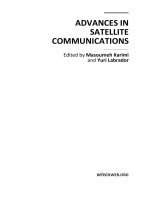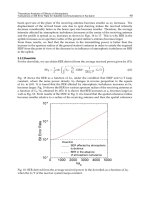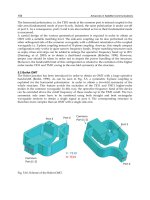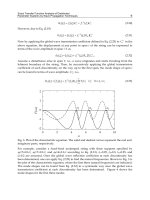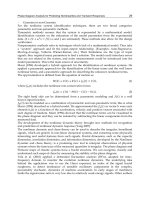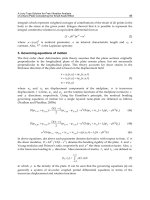Recent Advances in Vibrations Analysis Part 1 potx
Bạn đang xem bản rút gọn của tài liệu. Xem và tải ngay bản đầy đủ của tài liệu tại đây (463.73 KB, 20 trang )
RECENT ADVANCES IN
VIBRATIONS ANALYSIS
Edited by Natalie Baddour
Recent Advances in Vibrations Analysis
Edited by Natalie Baddour
Published by InTech
Janeza Trdine 9, 51000 Rijeka, Croatia
Copyright © 2011 InTech
All chapters are Open Access articles distributed under the Creative Commons
Non Commercial Share Alike Attribution 3.0 license, which permits to copy,
distribute, transmit, and adapt the work in any medium, so long as the original
work is properly cited. After this work has been published by InTech, authors
have the right to republish it, in whole or part, in any publication of which they
are the author, and to make other personal use of the work. Any republication,
referencing or personal use of the work must explicitly identify the original source.
Statements and opinions expressed in the chapters are these of the individual contributors
and not necessarily those of the editors or publisher. No responsibility is accepted
for the accuracy of information contained in the published articles. The publisher
assumes no responsibility for any damage or injury to persons or property arising out
of the use of any materials, instructions, methods or ideas contained in the book.
Publishing Process Manager Dragana Manestar
Technical Editor Teodora Smiljanic
Cover Designer Jan Hyrat
Image Copyright Eskemar, 2011. Used under license from Shutterstock.com
First published August, 2011
Printed in Croatia
A free online edition of this book is available at www.intechopen.com
Additional hard copies can be obtained from
Recent Advances in Vibrations Analysis, Edited by Natalie Baddour
p. cm.
ISBN 978-953-307-696-6
free online editions of InTech
Books and Journals can be found at
www.intechopen.com
Contents
Preface IX
Part 1 Analytical Methods 1
Chapter 1 Exact Transfer Function Analysis of
Distributed Parameter Systems by
Wave Propagation Techniques 3
Bongsu Kang
Chapter 2 Phase Diagram Analysis for Predicting
Nonlinearities and Transient Responses 27
Juan Carlos Jáuregui
Chapter 3 A Levy Type Solution for Free Vibration
Analysis of a Nano-Plate Considering
the Small Scale Effect 47
E. Jomehzadeh and A. R. Saidi
Chapter 4 Second Order Shear Deformation Theory
(SSDT) for Free Vibration Analysis on a
Functionally Graded Quadrangle Plate 59
A. Shahrjerdi and F. Mustapha
Part 2 Vibrations Analysis for Machine Maintenance 79
Chapter 5 Maintenance of Reducers with an
Unbalanced Load Through Vibration
and Oil Analysis Predictive Techniques 81
Aparecido Carlos Gonçalves, Daniel Fabiano Lago
and Maria da Consolação Fonseca de Albuquerque
Chapter 6 Probabilistic Vibration Models in
the Diagnosis of Power Transformers 103
Pablo H. Ibargüengoytia, Roberto Liñan,
Alberth Pascacio and Enrique Betancourt
VI Contents
Chapter 7 Measurement of Satellite Solar Array
Panel Vibrations Caused by Thermal
Snap and Gas Jet Thruster Firing 123
Mitsushige Oda, Yusuke Hagiwara, Satoshi Suzuki,
Toshiyuki Nakamura, Noriyasu Inaba, Hirotaka Sawada,
Masahiro Yoshii and Naoki Goto
Part 3 Modelling and Analysis of Complex Systems 141
Chapter 8 Modelling and Vibration Analysis
of Some Complex Mechanical Systems 143
Tadeusz Markowski, Stanisław Noga and Stanisław Rudy
Chapter 9 Torsional Vibration of Eccentric Building Systems 169
Ramin Tabatabaei
Chapter 10 Beam Structural Modelling in Hydroelastic
Analysis of Ultra Large Container Ships 193
Ivo Senjanović, Nikola Vladimir,
Neven Hadžić and Marko Tomić
Chapter 11 Stochastic Finite Element Method
in Mechanical Vibration 223
Mo Wenhui
Preface
This book covers recent advances in modern vibrations analysis, from analytical
methods to applications of vibrations analysis to condition monitoring.
The book opens with a section on recent advances in analytical methods. Dr. Kang
Bongsu contributed a chapter that presents an alternative technique for the free and
forced vibration analysis of one-dimensional distributed parameter systems. This
approach is based on the idea of superimposing the amplitudes of the constituent
travelling waves, rather than the traditional approach of normal mode expansion that
relies on the apriori calculation of eigensolutions or assumed normal modes.
In the second chapter, Juan Carlos Jáuregui presents an application of phase space to
the identification of nonlinearities and transients. In this interesting approach, a phase
diagram is represented as a three-dimensional plot which can then be used for
frequency and dynamic identification of a system. The application of this approach to
nonlinear mechanical systems such as gears, bearings and friction is also included in
the chapter.
The next chapter presents an analytical solution for a nano-plate with Levy boundary
conditions. The free vibration analysis is based on a first order shear deformation
theory which includes the small scale effect. The governing equations of motion,
reformulated as two new equations called the edge-zone and interior equations, are
based on the nonlocal constitutive equations of Eringen.
A. Shahrjerdi and F. Mustapha co-authored the fourth chapter, which discusses
second-order shear deformation theory applied to a plate with simply supported
boundary conditions. The material properties of the plate are graded in the thickness
direction by a power law distribution and the equations of motion are derived via the
energy method and then solved by applying Navier's method. It is interesting to note
that the authors demonstrate that the results of the second-order theory are very close
to those reported in the literature using a third-order theory.
The next section of the book deals with the application of vibrations analysis to the
condition monitoring and maintenance of various machines. The first chapter in this
section deals with the maintenance of reducers that have unbalanced loads. The most
X Preface
commonly used maintenance approaches for reducers are oil analysis (via laboratory
chemical analysis) and separately, vibrations analysis. In this chapter, a novel way of
combining the two approaches for more accurate results is presented.
The second chapter in this section presents an alternative method for detecting failures
in transformers via the analysis of the vibrations produced inside the transformer
under operation. Normally, the transformer produces vibrations in the windings and
the core, and these vibrations vary according to operating conditions. However, in the
presence of mechanical failure, the vibration patterns are different from those
produced by normal conditions. This idea is used as the basis for a failure detection
mechanism, with the promise that this approach makes it possible to design an on-line
real-time diagnosis system.
The final chapter in this section describes an interesting method for monitoring the
thermal snap of satellites, an effect which has been known to cause attitude
disturbance in Low Earth Orbit satellites. The difficulty with these types of thermally
induced vibrations is that they are very slow and cannot be monitored via a traditional
sensor-driven approach. This chapter thus describes a novel approach to this problem
via an onboard monitoring camera. Images taken in space and the image processing
of these images are explained.
The third and final section of the book deals with the modelling and analysis of
various complex mechanical systems. In particular, the first chapter of this section
deals with the vibrations analysis of several mechanical systems possessing complex
design and geometry. Specific systems considered include a fatigue test rig for
aviation gear boxes, a gas turbine blade and finally an annular membrane resting on
an elastic foundation of a Winkler type.
The next chapter in this section considers the free vibration of eccentric building
systems. In particular, the coupled torsional-translational vibrations of both
symmetric and eccentric one-storey building systems subjected to ground excitation
are modelled and then analysed.
In the subsequent chapter, the structural modelling of beams as part of the
hydroelastic analysis of large container ships is presented. In developing these
models, it is important to appropriately account for the contribution of transverse
bulkheads to hull stiffness and the behaviour of the relatively short engine room
structure. The application of this approach to the hydroelastic analysis of a very large
container ship is then illustrated.
The final chapter deals with the use of the stochastic finite element method for
vibrations analysis. Although the finite element method analysis of complicated
structures has become generally accepted, regarding the given factors as known
constants does not always correspond to the reality that material properties, geometry
parameters and applied loads of the structure are often modelled as stochastic. Thus,
Preface XI
how to incorporate the stochastic nature of these parameters into a finite element
model is shown.
I would like to express warm thanks to all the contributors, in particular for their
efforts to ensure that difficult material is made accessible to wider audience.
Dr. Natalie Baddour
Department of Mechanical Engineering
University of Ottawa
Canada
Part 1
Analytical Methods
1
Exact Transfer Function
Analysis of Distributed
Parameter Systems by Wave
Propagation Techniques
Bongsu Kang
Indiana University – Purdue University Fort Wayne
USA
1. Introduction
The vibrations of elastic structures such as strings, beams, and plates can be described in
terms of waves traveling in waveguides (Cremer et al., 1973; Graff, 1975; Fahy, 1987). While
the subject of wave propagation has been extensively studied in the fields of acoustics in
fluids and solids rather than vibrations of elastic structures, wave analysis techniques have
been employed to reveal physical characteristics associated with structural vibrations of
elastic media (Argento & Scott, 1995; Kang & Tan, 1998). One of the advantages of the wave
analysis technique, when applied to the structural vibration analysis, is its compact and
systematic approach to analyze complex structures with discontinuities (Mace, 1984; Yong &
Lin, 1989; Kang et al., 2003; Mei & Mace, 2005). Applying the concept of wave reflection and
transmission, Mace (1984) obtained the frequency equations of Euler-Bernoulli beams
including waves of both propagating and near-field types. By the phase-closure principle,
also referred to as the wave-train closure principle (Cremer et al., 1973), Mead (1994)
determined natural frequencies of Euler-Bernoulli beams. This principle states that if the
phase difference between incident and reflected waves is an integer multiple of 2
, then the
waves propagate at a natural frequency and their motions constitute a vibration mode.
Based on the same principle, Kang (2007) presented a systematic approach to the free and
forced vibration analysis of multi-span beams.
The classical method, known as the normal mode or eigenfunction expansion, of solving the
forced vibration problem of a distributed parameter system involves expansion of the
forcing function into the eigenfunctions of the associated free vibration problem. While this
method is theoretically sound and powerful, the method is difficult to implement when the
problem to be solved is a non-self-adjoint system typically due to complicating effects such
as damping, discontinuities, or non-classical boundary conditions, for which case obtaining
the exact eigensolutions is not often feasible. Although approximate eigensolutions may be
used instead of exact ones, the problem still persists in the form of poorly convergent
solution and/or significant error in the solution. As an alternative approach to solve forced
vibration problems, Yang and Tan (1992) presented a method for evaluating exact closed-
Recent Advances in Vibrations Analysis
4
form transfer functions for a class of one-dimensional distributed parameter systems.
Applying the energy functionals of constrained and combined damped systems, Yang
(1996a, 1996b) presented a method to obtain a closed-form transient response solution in
eigenfunction series for a distributed damped system.
The dynamic displacement of any point in an elastic waveguide can be determined by
superimposing the amplitudes of the constituent waves traveling along the waveguide,
which is a basis of wave propagation. Based on this simple fact, an alternative technique for
the free and forced vibration analysis of one-dimensional distributed parameter systems is
presented. The method of normal mode expansion is often difficult to implement for
nonself-adjoint systems with complicating effects such as mode couplings, non-proportional
damping, discontinuities, or arbitrary boundary conditions, since the method requires
eigensolutions or assumed normal modes as a priori. However, this alternative analysis
technique based on the elastic wave propagation does not pose such a requirement and
leads to the exact, closed-form, distributed transfer function of a distributed parameter
system. The general wave solution of the equation of motion governing the dynamics of a
waveguide is cast into a matrix form in terms of the constituent waves defined in the
Laplace domain. The spatial amplitude variation of the traveling wave is represented by the
field transfer matrix and the amplitude distortion of the traveling wave incident upon a
discontinuity due to geometric or kinetic constraints is described by the local wave
reflection and transmission matrices. Combining these matrices in a progressive manner
along the waveguide by applying the concepts of global wave reflection and transmission
matrices leads to the exact characteristic equation and corresponding mode shapes for the
free response analysis and the transfer function of the system for the forced response
analysis. The transient response solution for a complex system can be obtained through the
Laplace inversion of the transfer function using numerical inversion algorithms. The exact
frequency response solution, which includes infinite normal modes of the system, can be
obtained in terms of the complex frequency response function from the transfer function.
One of the main advantages of this analysis technique is its systematic formulation resulting
in a recursive computational algorithm which can be implemented into highly efficient
computer codes. This systematic approach also allows modular formulation which can be
readily expandable to include additional discontinuities with little alteration to the existing
formulation. In addition, it is also computationally advantageous that the technique always
results in operating matrices of a fixed size regardless of the number of discontinuities in a
waveguide. This analysis technique is applicable to any one-dimensional waveguides
(strings, axial rods, torsional bars, beams, and frame structures), in particular systems with
multiple point discontinuities such as viscoelastic supports, attached inertias, and
geometric/material property changes. The analysis technique is demonstrated using the
second order wave equation, fourth order beam equation, and sixth order curved beam
equation.
2. Second order systems
The free transverse vibration of a taut string, longitudinal vibration of a thin bar, and the
torsional vibration of a shaft are governed by the equation of motion in the same form, the
wave equation, and thus they are mathematically analogous. Therefore, with no loss of
generality, the transverse vibration of the string is taken as a representative problem for the
description of the present analysis technique based on wave propagation. The equation
governing the transverse motion of a uniformly damped string of span length L is
Exact Transfer Function Analysis of Distributed
Parameter Systems by Wave Propagation Techniques
5
22
22
e
WW W
TCm
t
Xt
(2.1)
where W is the transverse displacement, X the spatial variable, t the temporal variable; and
T denotes the constant tension, C
e
the damping coefficient, and m the mass per unit length of
the string. With introduction of the following non-dimensional variables and parameters
wWL
xXL
0
tt
0ee
cCLt
00
tLc
0
cTm (2.2)
the equation of motion takes the non-dimensional form of
e
wcww
(0 1)
x
(2.3)
where the prime (‘) and dot () denote the differentiation with respect to x and
,
respectively. Applying the Laplace transform to Eq. (2.3) yields
2
(;) (;) (;)
e
w xs cswxs swxs
(2.4)
where s denotes the Laplace variable and zero initial conditions are assumed.
2.1 Wave solution
Denoting C as the amplitude of the wave traveling along the string, the solution of Eq. (2.4)
can be assumed in wave form
(;)
ix
wxs Ce
(2.5)
where
is the non-dimensional wavenumber normalized against span length L. Applying
the above wave solution to Eq. (2.4) gives the frequency equation of the problem
e
scs
22
0
or
22
e
cs s
(2.6)
from which the general wave solution can be found as the sum of two constituent waves
(;)
ix ix
wxs C e C e
(2.7)
where the coefficient C represents the amplitude of each wave component with its traveling
direction indicated by the plus (+) or () sign. Note that
is complex valued for nonzero c
e
,
hence the classification of the wave into propagating and attenuating waves does not apply
to this case. Defining ( ; )
ix
fxs e
as the field transfer function which relates the wave
amplitudes by
00
() ()Cxx
f
Cx
or
1
00
() ()Cxx
f
Cx
(2.8)
where
1
(;)
ix
f
xs e
, the wave solution in Eq. (2.7) can be re-written as
1
(;)wxs
f
C
f
C
(2.9)
Recent Advances in Vibrations Analysis
6
2.2 Wave reflection and transmission
When a wave traveling along a string is incident upon a discontinuity such as an elastic
support, geometric/material property change, or boundary, it is reflected and transmitted at
different rates depending on the properties of the discontinuity. The rates of wave reflection
and transmission can be determined in terms of wave reflection and transmission coefficients.
For example, consider an infinitely long string constrained at a local coordinate
0
as
shown in Fig. 1, where the constraint is a point support consisting of an attached mass (M
c
),
a transverse spring (
K
c
), and a viscous damper (C
c
).
Fig. 1. Wave reflection and transmission at a discontinuity.
When a positive-traveling wave
C
is incident upon the support, it gives rise to a reflected
wave
rC
and a transmitted wave tC
, where r and t represent the wave reflection and
transmission coefficients, respectively. The resulting transverse displacements at the left and
right of the constraint are
l
wC rC
r
wtC
(2.10)
Since
lr
ww at
=0, one can find
1
rt
(2.11)
In addition, the kinetic equilibrium condition at
=0 states that
rl r
ww w
(2.12)
where
represents the kinetic properties of the constraint as
2
()
cc c
skcsms
(2.13)
Note that
k
c
, c
c
, and m
c
in Eq. (2.13) are the non-dimensional spring constant, damping
coefficient, and the attached mass, respectively, defined by
cc
kKLT
0cc
cCcT
2
0cc
mMcTL (2.14)
Equation (2.12) leads to
(1)rt it
(2.15)
Combining Eqs. (2.11) and (2.15), the wave reflection and transmission coefficients can be
found as
2
i
r
i
and
2
2
t
i
(2.16)
0
tC
C
rC
Exact Transfer Function Analysis of Distributed
Parameter Systems by Wave Propagation Techniques
7
When a wave is incident upon a boundary at
=0, it is only reflected, therefore
ll
ww
(2.17)
which leads to
i
r
i
(2.18)
In the limiting case where
=, it can be seen that r=1 which is the wave reflection
coefficient for the classical fixed boundary. When the wave is incident upon a series of
discontinuities along its traveling path, it is more computationally efficient to employ the
concepts of global wave reflection and transmission coefficients, in particular when the free or
forced vibration analysis of a multi-span string is sought. These coefficients relate the
amplitudes of incoming and outgoing waves at a discontinuity. Consider wave motion in a
multi-span string as illustrated in Fig. 2. Define R
ir
as the global wave reflection coefficient
which relates the amplitudes of negative- and positive-traveling waves on the right side of
discontinuity i such that
ir ir ir
CRC
(2.19)
Fig. 2. Waves traveling along a multi-span string.
Since
(1)ir i i l ir
CfRC
, one can find R
ir
in terms of the global wave reflection coefficient on
the left side of discontinuity i+1; i.e.,
2
(1)ir i i l
RfR
(2.20)
In addition, by combining the following wave equations at discontinuity i
ir i il i ir
CtCrC
and
il i ir i il
CtCrC
(2.21-22)
the relationship between the global wave reflection coefficients on the left and right sides of
discontinuity i can be found as
21 1
()
il i i ir i
RrtR r
(2.23)
R
ir
and R
il
progressively expand to include all the global wave reflection coefficients of
discontinuities along the string before terminating its expansion at the boundaries where
111
CrC
nnn
CrC
(2.24)
ir
C
il
C
ir
R
il
R
il
C
nl
R
n
C
(1)ir
C
1
C
(1)ir
R
(1)il
R
(1)ir
C
(1)i
f
n
C
n
i
1i
1
C
1
ir
C
1r
R
Recent Advances in Vibrations Analysis
8
While the global wave reflection coefficient relates the amplitudes of waves traveling in the
opposite direction of each other within a subspan
i, there is a need for another coefficient
which relates the amplitudes of waves traveling in the same direction in two adjacent
subspans. This inter-span coefficient is particularly useful when the mode shape or forced
response of a string with several or more subspans needs to be determined since it allows an
intuitive and systematic formulation of the system’s transfer function. Denoting this inter-
span wave transfer coefficient as the
global wave transmission coefficient T
i
, define
(1)ir i i r
CTC
(2.25)
Rewriting Eq. (2.21) by applying
(1)(1)il i i r
CfC
and
ir ir ir
CRC
, and then comparing it
with Eq. (2.25), the global wave transmission coefficient at discontinuity
i can be found as
1
(1)
(1 )
iiirii
TrRtf
(2.26)
The global wave reflection and transmission coefficients are the key elements in determining
the exact transfer function of a multi-span string as discussed in the following sections.
2.3 Free response analysis
The global reflection and transmission coefficients of waves traveling along a multi-span
sting are now combined with the field transfer function to analyze the free response of a
multi-span sting. With reference to Fig. 2, consider wave motion in the first span. Based on
the definition of the global wave reflection coefficient, at the boundary
111r
CRC
(2.27)
However, recalling
111
CrC
from Eq. (2.24), it can be found that
11 1
(1)0
r
rR C
(2.28)
For nontrivial solutions,
11
() 1 0
r
Fs rR
(2.29)
which is the characteristic equation in terms of the Laplace variable
s for the multi-span
string with arbitrary discontinuities and boundaries. This remarkably simple expression for
the characteristic equation is due to the fact that
R
1r
recursively expands to include all the
effects of constraints in the remaining side of the string until its expansion terminates at the
rightmost boundary which yields
R
nl
r
n
. This equation simply states that when the string
system vibrates at one of its natural frequencies,
r
1
R
1r
1. As a simple example, for a single
span uniformly damped string fixed at both ends,
r
1
r
2
1 from Eq. (2.18) and R
1r
e
2i
from
Eq. (2.20). Therefore,
F(s)e
2i
10 gives the natural wavenumbers
n
n
(n1,2,3, ), or in
terms of the non-dimensional frequency
22
()
nen
ic n
by Eq. (2.6) with s replaced
by
i
.
The mode shapes of the multi-span string system can be found in a systematic manner by
relating wave amplitudes between two adjacent subspans. Let
i
denote the local coordinate
within span
i. The transverse displacement at any point in span i can be expressed as


